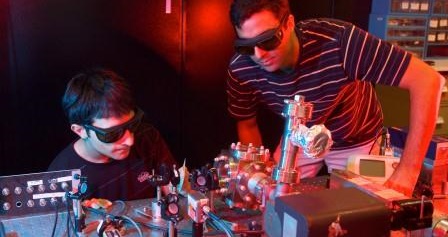Precision lifted on a bed of light
 Physicists from the Australian National University have developed a multi-pronged approach to measuring gravitational force, balancing a mirror on a tripod of lasers.
Physicists from the Australian National University have developed a multi-pronged approach to measuring gravitational force, balancing a mirror on a tripod of lasers.
While the breakthrough may eventually lead to the development of a floating dancefloor, propped-up by the laser power of future nightclubs – in the shorter term it will likely yield more sensitive sensors for gravitational shifts.
The new level of precision in gravitational measurement has been achieved by delicately levitating a tiny mirror on a bed of light, created by three converging laser beams.
Professor Ping Koy Lam from the ANU Department of Quantum Science says light can be collected from the floating reflector.
Prof Lam’s associate Dr Ben Buchler says: “Imagine you’ve got something above you and you are throwing ping pong balls at it to keep it in the air... Levitating using lasers works in a similar way, but the ping pong balls are light particles being fired at the mirror.”
“Most of the light in other laser levitation systems is scattered, but since we are levitating a mirror we are reflecting that light back and we can retrieve the information from it,” said researcher Giovanni Guccione.
By levitating a convex mirror, physicists were able to measure its movements with incredible precision.
“You can measure the position of the mirror very precisely because you are using a laser to do the measurement,” physicist Dr Mahdi Hosseini says.
“If the position of the mirror changes slightly due to any external force, such as gravity, you can work out how much force has been applied to the mirror.”
The most likely application for the technique may be in mineral sensing, where various underground densities cause minor gravitational fluctuations.
The researchers have floated some loftier goals though, hoping to use the photonic platform to confirm or rule out aspects of competing quantum gravity theories.









 Print
Print